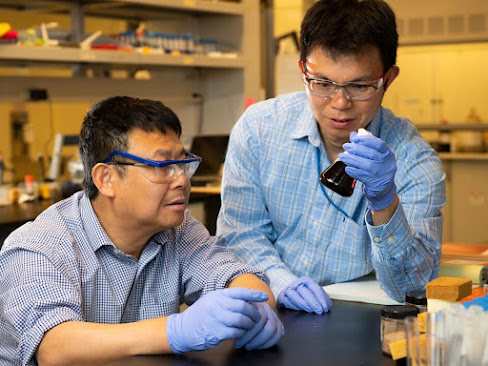 |
| Researchers Xiao Zhang (L) and Chun-long Chen (R) examine the products of lignin digestion by their novel biomimetic peptoid catalyst. Photo by Andrea Starr | Pacific Northwest National Laboratory |
A new artificial enzyme has shown it can chew through lignin, the tough polymer that helps woody plants hold their shape. Lignin also stores tremendous potential for renewable energy and materials.
Reporting in the journal Nature Communications, a team of researchers from Washington State University and the Department of Energy’s Pacific Northwest National Laboratory showed that their artificial enzyme succeeded in digesting lignin, which has stubbornly resisted previous attempts to develop it into an economically useful energy source.
Lignin, which is the second most abundant renewable carbon source on Earth, mostly goes to waste as a fuel source. When wood is burned for cooking, lignin byproducts help impart that smoky flavor to foods. But burning releases all that carbon to the atmosphere instead of capturing it for other uses.
“Our bio-mimicking enzyme showed promise in degrading real lignin, which is considered to be a breakthrough,” said Xiao Zhang, a corresponding author on the paper and associate professor in WSU’s Gene and Linda Voiland School of Chemical Engineering and Bioengineering. Zhang also holds a joint appointment at PNNL. “We think there is an opportunity to develop a new class of catalysts and to really address the limitations of biological and chemical catalysts.”














.jpg)
